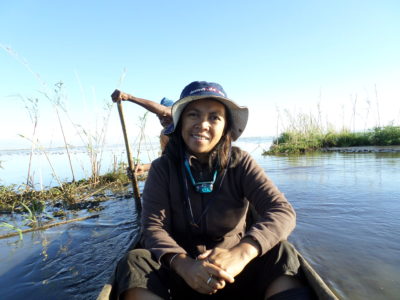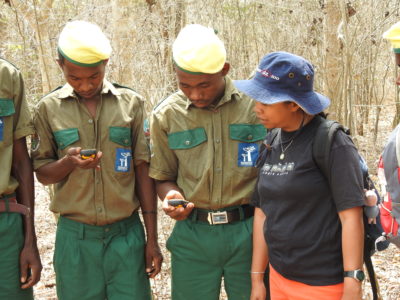
Today’s guest blogger is Sylvaine Volampeno, who runs Mikajy Natiora.
As a Malagasy native I got involved in conservation since 2002. My country is very rich and unique in terms of biodiversity, so I chose to focus my research on one of the many highly endangered lemur species that are endemic to my home country. I received my Ph.D. in Zoology from the University of KwaZulu-Natal (South Africa), focusing on the Blue-eyed black lemur in the Sahamalaza-Iles Radama National Park, Madagascar.
In 2013, I established a Madagascar-based conservation association called Mikajy Natiora. My areas of interests include primate conservation and biological research, sustainable use of the ecosystem services and local community development, and environmental education.
My vision for SOS Lemurs is conservation of the threatened lemurs and the protection of their habitat as well as improvement of the well-being of the affected local communities.
Working with IUCN’s Save Our Species Program
Working with colleagues in IUCN’s Save Our Species allows me to help connect two important parts of the global conservation system: action on the ground to the international level of policy, awareness raising and donor priorities.
I am privileged to work closely with colleagues across Madagascar who have dedicated their careers to protecting lemurs and who appreciate the fundamental importance of this link.
Grants for conservation projects are a valuable interface between these two parts – channeling funds to communities and professionals to work on protecting species like lemurs while using systems and processes to report results and successes back to donors clearly and consistently.
When it works it is like a virtuous circle – better survival prospects for species, development prospects for communities and donor prospects for NGOs etc. But while getting a grant is a success in itself, it is just one of the first steps in the journey that will last for perhaps 1.5 years.
Learn More about SOS LemursWhat happens after you get a grant from Save Our Species?
What comes next for grantees is a question I am often asked. In one way, what happens next is up to the grantee. Proactive, well organised, good communicators—who have ambitious but realistic projects that are well managed from the start—will be more likely to attract more interest and support for their work.
An SOS grant can act as a catalyst to other sources of funding or support.
Of course there are also practical considerations in progressing from applicant to grantee to implementing grantee. Being based in Madagascar helps me to provide guidance to grantees along that journey in person.
What happens next is often very much about me being available to answer questions, consult on templates and forms, advise on planning, and act as liaison with the SOS Secretariat in IUCN headquarters. Being native Malagasy and fluent in French and English is helpful too – as a global organization the working languages of IUCN are English, French and Spanish and while the SOS Secretariat are all at least bilingual (English and French mostly), the working language is English even if they do have one or two Malagasy phrases thanks to my teaching efforts!
Assistance for Applicants
Prior the implementation of the project, successful applicants are asked to prepare several documents related to the project’s objectives, activity plan and budget. Applicants are also encouraged to think about their communications goals and design a simple plan that can help tell the story of the project by relating its successes, milestones and lessons learned.
Applicants should also look at the Save Our Species website to see how projects are presented and to reflect how they can harness SOS and IUCN’s communications channels – including social media – to help them.
Available during Proposal Process
As the Primate Specialist Group Programme Officer coordinating closely with the SOS Secretariat, I provide assistance and guidance to the grantees during the preparation of these documents as well as later during project implementation. These first steps toward implementation usually take a few weeks and a number of email exchanges. In some cases, applicants may be asked to revise slightly their proposals – perhaps the core concept is strong but the plan needs development for example.
Applicants should budget staff time to be available to work on refining project documents to ensure things like logical frameworks (logframes) make sense for the NGO as well as for the donor.
As part of the final agreement, grantees use templates to perform periodic project reporting while also sharing news regularly either via social media or in collaboration with the Secretariat on certain occasions. Remember the donor must also report on activities. In the case of SOS, it must coordinate project results from a portfolio of lemur projects to report as one cohesive story for its audiences.
Available After Project Implementation
Once the project is implemented, I work to ensure that the grantees maintain regular communication and are aware of reporting deadlines and remain available to advise on most technical queries.
I also conduct field site visits in order to learn more about the projects including the role of project participants, project beneficiaries, activities performed and achievements realised. These are also great opportunities to speak about and listen to any issue related to the project or provide guidance and advice if needs be.
Apply for SOS Grants
The latest Call for Proposals for SOS Lemur Initiative is open from 9th April 2018 until midnight Central European Time (CET) on 27th May 2018.
Potential applicants need to register and submit a proposal through the secure SOS online portal via the SOS website. Applicants should carefully read the criteria and grant eligibility information on the portal. Successful applicants will propose projects that support the implementation of the Lemur Conservation Strategy produced by the IUCN Species Survival Commission’s Primate Specialist Group in 2013.
Learn More and Apply Now
